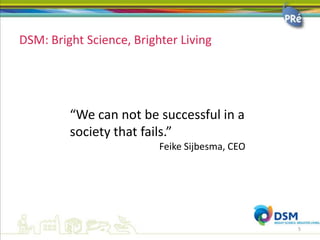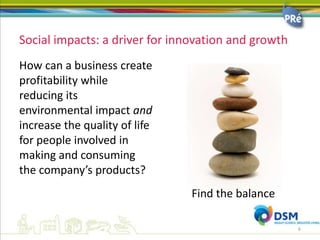Tools in Focus: The Evolving Landscape of Social Metrics
- 1. Applying social metrics to product evaluation September 28, 2012
- 2. Market Trend – a demand for transparency 2
- 3. The Triple P Approach (aka the triple bottom line) Planet Planet People Planet People People Profit Profit Profit 1980’s to mid 1990’s late1990’s 2000’s, balance? 3
- 4. Environmental product evaluation • Consensus on LCA methods and approaches • Increased customer demand and familiarity w/ footprints • Acknowledgement that cost efficiencies and reduced environmental impacts are achievable 4
- 5. DSM: Bright Science, Brighter Living “We can not be successful in a society that fails.” Feike Sijbesma, CEO 5
- 6. Social impacts: a driver for innovation and growth How can a business create profitability while reducing its environmental impact and increase the quality of life for people involved in making and consuming the company’s products? Find the balance 6
- 7. Developing the approach Get Gain Road-test Standardize Acquainted Cooperation Keep it simple! 7
- 8. What makes the social metrics approach unique? Supply Chain Value Chain Includes the Value Chain Along the Lifecycle + Both + and – Impacts Allows for Improvement Addresses Employees, Communities, Consumers - 8
- 9. Defining social stakeholders, themes & aspects Stakeholder Group Themes Aspects Healthy and safe working conditions Working Employees Remuneration Conditions Prevention of underage workers Healthy and safe living Community conditions Local Communities Development Local employment Provision of education Health and Well- Health condition Consumers being Comfort 9
- 10. Creating business value • Prerequisites: compliance with company values and international standards and internal coordination is essential for acceptance • Increases visibility into the supply chain • Helps companies identify and manage potential risks • Creates new opportunities for innovation and value propositions • Allows for enhanced sustainability communication to stakeholders 10
- 11. Environmental or financial or social indicators? Planet People Profit 11
- 12. Not a trade-off Planet People Profit 12
- 13. PRé and DSM’s social roundtable efforts • Conceived in early 2011 (PRé and several industry members) • Proposes a common approach for measuring and assessing the social impacts of products from a life cycle approach • Creates a platform for shared learnings • Three primary aspects – Harmonization of approaches – Dissemination Harmonize Inspire – Collaboration Start Engage mapping Influence Influence Scan other other common other major initiatives companies model and companies initiatives method
- 14. PRé and DSM PRé provides organizations with DSM provides nutritional and methods, tools and support to pharmaceutical ingredients and measure and improve sustainability performance materials to B2B from a life cycle perspective. customers worldwide. • In more than 21 countries • Global company, employing 22,000 • Serving more than 2,500 clients people. AR 9 bio eur. Headquarters in The Netherlands • Client industries ranging from • Recognized as one of the industry chemicals to retail to food & leaders by SAM (DJSI) agriculture • Mission: Bright Science. Brighter Living 14
- 15. J. Renée Morin Name Pré North America President, morin@pre-sustainability.com Job Title| <lastname>@pre-sustainability.com Jacobine J. Das Gupta – Mannak Royal DSM The Netherlands Corporate Sustainability Manager, jacobine.dasgupta@dsm.com















